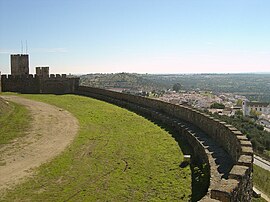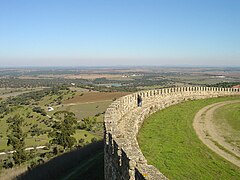Arraiolos
Arraiolos | |
|---|---|
 Arraiolos seen from the castle | |
 | |
| Coordinates: 38°43′N 7°59′W / 38.717°N 7.983°W | |
| Country | |
| Region | Alentejo |
| Intermunic. comm. | Alentejo Central |
| District | Évora |
| Parishes | 5 |
| Government | |
| • President | Silvia Pinto (CDU) |
| Area | |
| • Total | 683.75 km2 (264.00 sq mi) |
| Population (2021) | |
| • Total | 6,606 |
| • Density | 9.7/km2 (25/sq mi) |
| Time zone | UTC±00:00 (WET) |
| • Summer (DST) | UTC+01:00 (WEST) |
| Local holiday | Ascension Day date varies |
| Website | www |
Arraiolos (pronounced [ɐʁɐˈjɔluʃ] ) is a town and municipality in the Évora District of Portugal. As of 2021, the municipality had a population of 6,606 people[1] and covered an area of 683.75 square kilometres (264.00 sq mi).[2] The town itself was home to 3,133 residents in the same year.[1]. The current Mayor is Silvia Pinto, elected by the Unitary Democratic Coalition.
The town is famous for its castle and its embroidered wool rugs and carpets. Arraiolos rugs have been made since the Middle Ages.[3]
In October 2003, Jorge Sampaio, the then President of Portugal, invited the Presidents of Finland, Germany, as well as of soon-to-be EU members Hungary, Latvia and Poland to Arraiolos in order to discuss the consequences of the 2004 enlargement of the European Union and plans for a Constitution for Europe.[4] Subsequent meetings of non-executive presidents of European Union member states have been dubbed Arraiolos meetings.
History
[edit]Archaeological evidence suggests that the area around Arraiolos has been inhabited since at least the late Neolithic or Chalcolithic periods, indicating significant human occupation as early as the 4th millennium BCE. Historians believe that during protohistoric times, the site of the present-day Castle of Arraiolos served as a central habitat.[5] Prehistoric objects were excavated from a tumulus in Arraiolos at the beginning of the twentieth century. These included a trapezoid-shaped plaque with geometric design and three pottery vessels. These are now housed in the British Museum[6] with similar discoveries also reported in Vendas Novas.
A Roman settlement may have existed in the area around Arraiolos. Evidence suggests that the Church of Santana do Campo was constructed over the remains of a Roman temple, with remnants visible in the church structure and nearby constructions, including the southern cemetery wall. A Roman inscription was also found nearby at Herdade da Ravasqueira. This settlement is believe to have corresponded to a vicus, a small agricultural community that evolved from an indigenous site under Roman influence. Historians have suggested that this settlement may have been called "Calântica." Others trace its origins to Sabine, Tusculan, and Alban settlers who are believed to have arrived in the area before the Sertorian Wars, led by a figure named Rayeo. This name, "Rayeo," could be the root of "Rayolis," which eventually evolved into Arraiolos.[7]
During the Islamic period, Arabic sources offer few details on the region, aside from the growing importance of Évora from the 10th century onward. In 1165, the area around Arraiolos likely was reconquered by Gerald the Fearless during the reign of King Afonso Henriques.[7]
In 1217, King Afonso II granted the land of Arraiolos to Soeiro, the Bishop of Évora. This land largely corresponded to today's municipality, with the exception of Vimieiro, which would be granted a charter (foral) in 1257 by bishop Martinho of Évora. However, under King Afonso III, both Arraiolos and Vimieiro would return to the hands of the crown, in 1271.[7]
Arraiolos received its first charter from King Denis in 1290, who also commissioned the construction of the town’s castle. On December 26, 1305, a contract for the castle's construction was formalized between the king and representatives of the town council, João Anes and Martim Fernandes.[5][7][8]
The land remained under the control of the Portuguese crown for less than a century. King Pedro I granted it to Rodrigo Afonso de Sousa, the son of Afonso Dinis, who was the illegitimate son of King Afonso III. After Sousa's death, the land was given to Álvaro Pires de Castro, the brother of Inês de Castro and the title of count of Arraiolos was created.[7]
In 1387, Nuno Álvares Pereira, the Constable of Portugal, became the second count of Arraiolos, the Constable of Portugal and the second Count of Arraiolos. He spent significant time in Arraiolos before later joining the Carmo Convent in Lisbon. The town's charter was renewed in 1511 by King Manuel I.[5]
The first population count in Arraiolos took place between 1527 and 1532, following a census by King John III. The entire land of Arraiolos comprised 760 households, which corresponds to approximately 3,500 people. No separate figures exist for just the town. This placed Arraiolos among the 17 most populous urban centers in Alentejo at the time.[7]
Arraiolos experienced several administrative changes over the centuries. Its boundaries were first formally defined in 1736. In 1835, it was incorporated into the Évora District, followed by the annexation of the Vimieiro municipality in 1855. Mora municipality was annexed in 1895 but separated again in 1898.[5]
Parishes
[edit]Administratively, the municipality is divided into 5 civil parishes (freguesias):[9]
- Arraiolos
- Gafanhoeira e Sabugueiro
- Igrejinha
- São Gregório e Santa Justa
- Vimieiro
Notable people
[edit]- Joaquim Heliodoro da Cunha Rivara (1809 in Arraiolos – 1879 in Évora) a physician, professor, intellectual and politician
- Francisco José Caeiro (1890 in Vimieiro – 1976) a politician and former Minister and law professor.
- José Caeiro da Mata (1883 in Vimieiro – 1963) jurist, law professor and former Minister of Foreign Affairs.
Gallery
[edit]-
A house in Arraiolos.
-
The local castle.
-
View of the countryside from the castle.
References
[edit]- ^ a b INE, ed. (2021), Censos (in Portuguese), Lisbon, Portugal: Instituto Nacional de Estatística
- ^ "Áreas das freguesias, concelhos, distritos e país". Archived from the original on 2018-11-05. Retrieved 2018-11-05.
- ^ Fleming, John & Hugh Honour. (1977) The Penguin Dictionary of Decorative Arts. London: Allen Lane, p. 35. ISBN 0713909412
- ^ "Foreign Policy Events, 13-20 October 2003". Ministry of Foreign Affairs (Latvia). Archived from the original on 9 December 2014. Retrieved 5 October 2013.
- ^ a b c d "Apontamento Histórico". Visitar Arraiolos. Retrieved 2024-11-06.
- ^ British Museum Collection
- ^ a b c d e f Paulo, Sandra Cristina Espingardeiro (2007). Arraiolos Medieval, organização do espaço e estruturas sociais (masterThesis thesis). Universidade de Évora.
- ^ "Heráldica". Portal Institucional do Município de Arraiolos (in European Portuguese). Retrieved 2024-11-06.
- ^ Diário da República. "Law nr. 11-A/2013, page 552 19" (pdf) (in Portuguese). Retrieved 16 July 2014.
External links
[edit]![]() Media related to Arraiolos at Wikimedia Commons
Media related to Arraiolos at Wikimedia Commons





